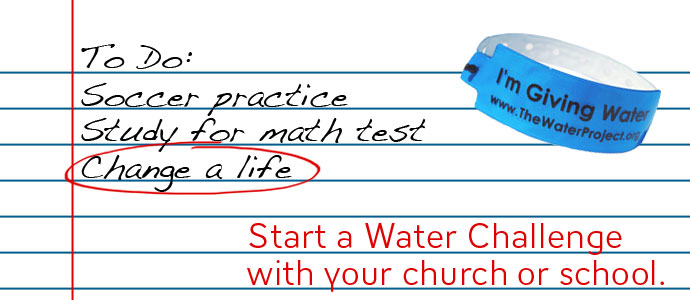Keep on Digging - Tools for Researching the Water Crisis
This annotated bibliography should give you some insights into the different sources that we've used at The Water Project and may help you in your own research to see where you might want to keep digging to learn more.
AQUASTAT
Food and Agriculture Organization of the United Nations
http://www.fao.org/nr/water/aquastat/water_use/index.stm
AQUASTAT provides the United Nations with statistics on water with a focus on agriculture. They look at water resources, uses and agricultural water management. They focus on Africa, Asia, Latin America and the Caribbean. AQUASTAT provides information in country/regional fact sheets and maps as well as providing reports on water usage and withdrawal. On The Water Project website, we use AQUASTAT statistics when we talk about how water is used around the world for agriculture, industry and household purposes.
United Nations
Statement by Secretary General Koffi Annan. June 2003.
http://www.un.org/News/Press/docs/2003/sgsm8707.doc.htm
Former Secretary General of the United Nations, Koffi Annan, gave a statement on June 5, 2003 for World Environment Day. His speech focused on water and the need for the UN to increase their efforts to breakdown the barriers that lead to economic water scarcity and increased disease in the developing world. The Water Project has used this speech to emphasize the huge portion of disease developing countries that could be prevented through improved water sources.
United Nations Development Programme
"Human Development Report 2006: Beyond Scarcity: Power, Poverty and the Global Water Crisis." 2006.
http://hdr.undp.org/en/reports/global/hdr2006/
The United Nations Development Programme (UNDP) is the United Nations Agency that targets all sorts of development issues to try to alleviate poverty around the world. The Human Development Report is an annual report that addresses various obstacles to development. The 2006 report focused on the global water crisis. The report itself gets very technical in some places and so the UNDP also provides a Summary and a Youth Booklet with the highlights from the report. The Water Project has used this report for facts relating to health and education.
United Nations Development Programme
"Resource Guide on Gender and Climate Change." 2009.
http://www.undp.org/climatechange/library_gender.shtml
The UNDP Resource Guide is a smaller report than the UNDP Annual Development Report as it focuses just on gender and climate change at large. It looks at how gender and climate change impact each of the Millennium Development Goals. The Water Project has used this report in explaining how water collection is especially detrimental for women's development.
UNICEF
"Water, Sanitation and Hygiene" Updated May 2010
http://www.unicef.org/media/media_45481.html
The United Nations Children's Fund, better known as UNICEF, is the United Nations Agency that focuses on children. UNICEF has all sorts of information about various issues that impact children, including waterborne diseases and water supply. This particular link is primarily a summary of the past several years of reporting on water and sanitation issues. At The Water Project, we've used information from this link to discuss how a lack of water in schools causes girls to miss class after reaching puberty.
World Health Organization
"Costs and benefits of water and sanitation improvements at the global level."
http://www.who.int/water_sanitation_health/wsh0404/en/
The World Health Organization (WHO) addresses all sorts of global health issues, from disease to unhealthy behaviors. This particular document explains how improving water and sanitation can improve the entire global economy. Because it is written in very high level economic terms, some people may prefer to simply use the executive summary. At The Water Project, we have referenced both documents for quoting statistics on the economic impact of clean water.
WHO/UNICEF Joint Monitoring Programme for Water Supply and Sanitation.
"Progress on Sanitation and Drinking Water 2010."
http://www.wssinfo.org/
The Joint Monitoring Programme (JMP) is the principal mechanism for analyzing and monitoring the progress of the United Nations Millennium Development Goal 7c which aims to halve the portion of the population without access to drinking water and improved sanitation. Every two years they publish a report with detailed statistics on water and sanitation on the national, regional and global levels. At The Water Project, we've used their information in many of the statistics relating specifically to access to toilets, and improved water sources.
WHO/UNICEF
"Diarrhoea: Why children are still dying and what can be done." 2009.
http://www.unicef.org/health/index_51412.html
This report is written jointly by UNICEF and the WHO and focuses on diarrhea, a health issue that is the second leading killer in children under 5 years of age. Like many reports from these major global agencies, it breaks down the problem (in this case diarrhea), gives a status report, and then presents a plan for how to potentially fix the problem. The Water Project uses this report for our statistics of waterborne disease and global health.
Additional Resources:
We haven't quoted from these sources directly, but they are great to know!
UN-Water "Welcome to UN-Water"
http://www.unwater.org/
UN Water is meant to be a one-stop-shop for everything that the United Nations does regarding water. The JMP, for example is one of their programs. They also put out the World Water Development Report and the Global Annual Assessment on Sanitation and Drinking Water.
United Nations "Millennium Development Goals"
http://www.un.org/millenniumgoals/
The United Nations Millennium Development Goals website gives information on each of the goals and their specific targets. There is a Youth section that specifically gives students a way to get involved in the solutions.
UN Millennium Project Task Force on Water and Sanitation.
"Health, dignity and development: What will it take?" 2005.
http://www.unmillenniumproject.org/documents/What_Will_It_Take.pdf
This report was written by the UN Millennium Project Task Force on Water and Sanitation. It tracks each of the Millennium Development Goals and explains a little bit about how providing people with clean and safe water can potentially impact almost all of the goals.
